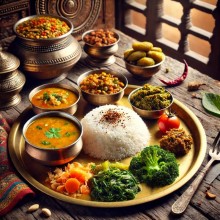Nepal, a land of breathtaking landscapes and rich traditions, is a place where culture and cuisine intertwine seamlessly. Every festival, ritual, and daily practice carries a deep significance, often expressed through food. The flavors of Nepal tell stories of heritage, community, and spirituality, making each dish more than just a meal—it’s a cultural experience.
Let’s take a journey through Nepal’s most cherished rituals and the delicious recipes that accompany them.
Dashain: A Festival of Blessings and Khasi Ko Masu (Goat Curry)
The Ritual:
Dashain, the longest and most revered festival in Nepal, celebrates the victory of good over evil. Families reunite, elders bless the younger generation with tika (a sacred mixture of rice, yogurt, and vermillion), and homes resonate with joy and togetherness. Feasts are a vital part of Dashain, with Khasi Ko Masu (goat curry) being a signature dish enjoyed by many.
The Recipe: Khasi Ko Masu
Ingredients:
-
1 kg goat meat
-
2 onions, chopped
-
3 tomatoes, pureed
-
2 tbsp ginger-garlic paste
-
1 tsp turmeric, cumin, coriander, and garam masala
-
Fresh cilantro for garnish
Method:
-
Sauté onions in oil until golden brown, then add ginger-garlic paste.
-
Add goat meat and cook until browned.
-
Stir in the spices and tomato puree. Simmer until the meat is tender.
-
Garnish with fresh cilantro and serve with steamed rice or sel roti.
Why It Matters: Khasi Ko Masu symbolizes prosperity and togetherness, making it a staple dish during Dashain celebrations.
Tihar: Lights, Love, and Sel Roti
The Ritual:
Tihar, the festival of lights, is a time of honoring animals, strengthening sibling bonds, and worshipping Goddess Lakshmi. Homes illuminate with oil lamps, sisters bless their brothers with garlands and sweets, and families come together to celebrate.
The Recipe: Sel Roti (Rice Donuts)
Ingredients:
Method:
-
Grind soaked rice into a smooth batter, mixing in sugar and cardamom.
-
Heat oil and pour the batter in a circular motion to form rings.
-
Fry until golden brown. Serve with yogurt or spicy potato curry.
Why It Matters: The circular shape of Sel Roti represents eternity and the unbreakable bonds of love celebrated during Tihar.
Newari Nwaran: Welcoming Life with Bara
The Ritual:
In the Newari community, Nwaran, the naming ceremony of a newborn, is a significant event. Families gather to bless the baby, accompanied by feasts and traditional music. Bara, a protein-rich lentil pancake, is often served during this joyous occasion.
The Recipe: Bara (Savory Lentil Pancakes)
Ingredients:
-
1 cup black lentils (soaked)
-
1 tsp ginger, garlic, turmeric, and cumin
-
Minced meat or egg (optional)
-
Oil for frying
Method:
-
Grind lentils into a thick batter and mix with spices.
-
Spread the batter into small circles on a heated pan.
-
Top with minced meat or egg if desired.
-
Fry until crispy and serve with spicy chutney.
Why It Matters: Bara’s hearty texture represents strength and prosperity for the newborn’s journey ahead.
Daily Rituals: The Art of Dhido
The Ritual:
In Nepal’s rural areas, dhido, a traditional dish made from buckwheat or millet, is a staple food. Cooking dhido is an act of patience, often done over firewood while sharing stories.
The Recipe: Dhido with Gundruk
Ingredients:
Method:
-
Boil water and slowly stir in flour while continuously mixing.
-
Knead into smooth dumplings and serve with gundruk soup and spicy relish.
Why It Matters: Dhido symbolizes simplicity and resilience, reflecting the daily life of Nepal’s mountain communities.
Festive Feasts: Kwati, the Monsoon Elixir
The Ritual:
During Gun Punhi, a Newari festival, families prepare kwati, a nourishing nine-bean soup believed to boost immunity and ward off monsoon ailments.
The Recipe: Kwati
Ingredients:
-
9 types of sprouted beans (e.g., chickpea, soybean, mung bean)
-
1 tsp turmeric, cumin, garlic, and ginger
-
Jimbu (Himalayan herb)
Method:
-
Boil sprouted beans until tender.
-
Sauté spices and jimbu in oil, then add to the beans.
-
Simmer until flavors are well combined.
Why It Matters: Kwati’s combination of beans represents unity and the healing power of nature.
A Taste of Nepal’s Soul
In Nepal, food is more than just sustenance—it is a celebration of life, culture, and tradition. From the festive indulgence of Khasi Ko Masu to the comforting simplicity of Dhido, every dish tells a story. These recipes not only nourish the body but also carry forward the legacy of Nepal’s diverse heritage.
Hungry for more? Try these recipes at home or, even better—visit Nepal to experience them amidst the stunning Himalayan landscapes and warm hospitality.
Jam jam! (Bon appétit!)

-1740461640.jpg)


-1740130486.jpg)


-1740465568.jpg)

-1741245072.png)

